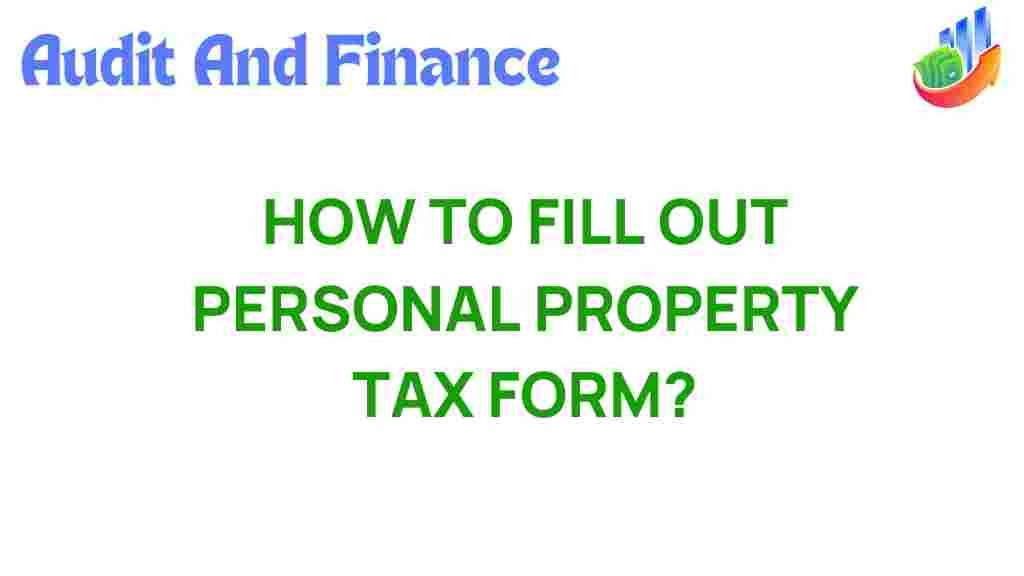Mastering the Personal Property Tax Form
Understanding and mastering the personal property tax process can seem daunting, but with the right guidance and information, it can be a straightforward task. This comprehensive guide will walk you through the tax form used for personal property tax, provide essential filing tips, explore property assessments, discuss available tax deductions, and highlight the importance of being aware of local regulations as part of your financial planning.
What is Personal Property Tax?
Personal property tax is a tax levied on movable assets owned by individuals or businesses that are not classified as real estate. This can include items such as vehicles, machinery, boats, and equipment. Unlike real property tax, which is based on the value of land and buildings, personal property tax is assessed based on the value of personal belongings.
Why is Filing Personal Property Tax Important?
Filing your personal property tax form accurately and on time is crucial for several reasons:
- It ensures compliance with local laws and regulations.
- It helps avoid penalties and interest due to late filings.
- It can lead to potential tax deductions if you qualify.
Step-by-Step Guide to Filing Your Personal Property Tax Form
Now that you understand the basics of personal property tax, let’s dive into the step-by-step process of filing your tax form.
Step 1: Gather Necessary Documentation
Before you begin filling out your form, it’s essential to gather all relevant documentation:
- Proof of ownership for each item.
- Purchase receipts and appraisals to establish value.
- Previous year’s tax forms (if applicable).
Step 2: Understand Local Regulations
Each state or locality may have specific requirements for personal property tax. Familiarize yourself with these regulations by:
- Visiting your local tax assessor’s website.
- Contacting the local tax office for clarification.
- Reviewing any guidelines or FAQs they provide.
Step 3: Complete the Personal Property Tax Form
Once you have all your documents in order, it’s time to complete the tax form. Here are some key sections to focus on:
- Identification Information: Fill in your name, address, and any identification numbers required.
- Property Listings: List each personal property item, including its description, purchase date, and value.
- Exemptions and Deductions: Research and apply any tax deductions you may qualify for.
Step 4: Review and Verify Information
Before submitting your form, take the time to review all information. Double-check for:
- Accuracy in listing property values.
- Correct personal information.
- Any missing signatures or required attachments.
Step 5: Submit the Form
Submit the completed tax form by the specified deadline. You may have options for submission:
- Online submission through your local tax office’s website.
- Mailing the form to the appropriate office.
- In-person delivery at your local tax office.
Step 6: Keep Records
After submission, retain a copy of your filed form and any supporting documents. This is important for:
- Future reference or audits.
- Verifying your records against future assessments.
Troubleshooting Common Filing Issues
Even with careful preparation, issues can arise during the filing process. Here are some common problems and how to troubleshoot them:
Missing Documentation
If you realize you’re missing a document after submission:
- Contact your tax assessor’s office to understand if you can provide it later.
- Keep a record of your efforts to obtain the missing documentation.
Incorrect Property Values
If you discover that you reported an incorrect value:
- Notify the local tax office as soon as possible.
- Provide evidence or support for the correct value.
Late Submission
If you miss the filing deadline:
- Contact your local office to understand penalties and potential remedies.
- Consider filing a late return to minimize penalties.
Exploring Tax Deductions and Property Assessment
Understanding available tax deductions and how property assessments work can significantly impact your overall tax liability.
Types of Tax Deductions
Depending on your location, you may qualify for various tax deductions, such as:
- Business Use Deductions: If you’re using personal property for business, you may qualify for deductions.
- Exemptions for Certain Property: Some states offer exemptions for agricultural equipment or other specific categories.
Understanding Property Assessment
Property assessments are conducted to determine the value of your personal property for tax purposes. Here’s how it typically works:
- Assessors evaluate the market value of your property based on current conditions.
- They may use sales data, cost analysis, or income approaches to establish value.
Final Thoughts on Financial Planning and Personal Property Tax
Mastering the personal property tax process is not only about compliance but also about effective financial planning. By understanding your obligations, taking advantage of possible tax deductions, and keeping informed about local regulations, you can optimize your financial situation and minimize your tax burden.
For more detailed information on tax-related topics, you can visit IRS.gov for resources and guidance.
Remember, if you have any questions or require assistance, don’t hesitate to reach out to a tax professional. Proper planning and timely filing can make a significant difference in managing your personal property taxes effectively.
By following these steps and utilizing the tips provided, you’ll be well on your way to mastering your personal property tax filings!
This article is in the category Taxation and created by AuditAndFinance Team
